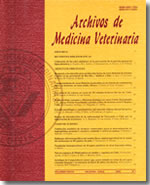Rotavirus in asymptomatic animals: Detection and antigenic classification
Main Article Content
Abstract
Rotavirus (RV) group A is associated with gastroenteritis in mammals and birds. The most frequently identified strains in sick animals belong to the serotypes G1-G3. Knowledge of the epidemiology of RV among asymptomatic animals is very limited.
The objective of this study was to determine the frequency and antigenic classification of RV strains isolated from asymptomatic animals that live both inside and outside homes. Five hundred houses were studied, of which 3773 faecal samples from different species of animals were collected. They were analyzed using the ELISA method specific for RV group A. Antigenic classification of RV was carried out using monoclonal antibodies from the subgroup and serotypes G and P.
Twenty houses were identified in which one animal each (4%) was found to be infected with rotavirus. Eight different serotype-subgroup antigenic combinations were detected. Fifteen out of the 20 positive samples(75%) belonged to subgroup no I/no II. All the samples reacted to antibodies against serotype G., the most common was G3 found in 50% of the samples.
The following 3 lines are not in the resumen and therfore should not be included in the summary either (or vice versa). Grammar and spelling are corrected below:
Serotype G1 was found in 35%, G2 15% and G4 in 10% and two animals had mixed infections. Only 30% of the samples reacted with antibodies against serotype P, the most common was P1A in 25% of the samples.
The presence of RV strains with antigenic characteristics frequently reported in humans, suggests that asymptomatic domesticated animals could act as reservoirs for infection with RV, maintaining this virus in circulation between the annual outbreaks in our environment.

